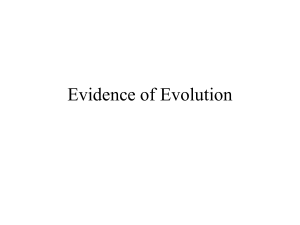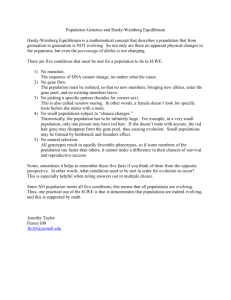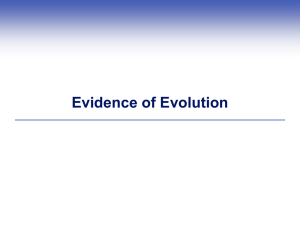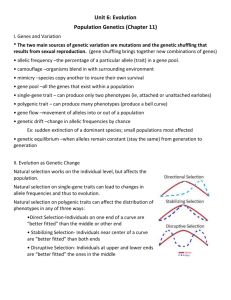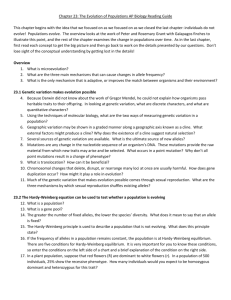pruitt_ppt_ch08
advertisement
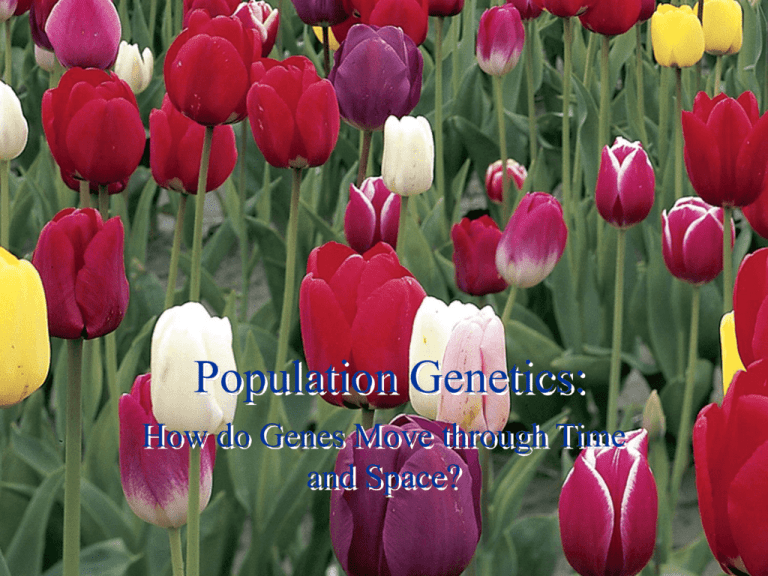
Population Genetics: How do Genes Move through Time and Space? How Do We Characterize Variation? • Variation can be smooth or discontinuous. – Two views of biology • “Naturalists” –Supported Darwin’s ideas. • “Experimentalists” –-Supported Mendelian Ideas. Naturalists’ Viewpoint • Saw most traits in a population exhibited a continuum of forms. • Believed the ability to survive and reproduce might depend on having traits that fall within some range of a spectrum. • Believe that traits within populations change or evolve as features of environmental change. Experimentalists’ Viewpoint • Rejected naturalists’ view of evolution. • Viewed variation as a sudden change due to mutations. • Maintained evolution progressed by leap and bounds by sudden random mutations. • Evolution could not be a gradual process Stalemate Broken • Herman Nilsson-Ehle (1909) – Using wheat kernels proved that traits that appear in populations as a continuous spectrum of forms with a genetic basis. Stalemate Broken • Nilsson-Ehle showed a cross between – true-breeding red- and white-kerneled plants – produced all light redkerneled plants • Cross between light red-kerneled plants yielded 7 categories of color. Frequency Diagrams Illustrate Variation • Useful graphing tool for illustrating variation in population • X-axis:range of different forms that a trait can exhibit • Y-axis number of individuals in population that exhibit each form of the trait Frequency Diagram of Human Height • Graphing human height creates a bell-shaped curve. • So many different forms that the categories blend. Frequency Diagram of Wheat Kernels • Frequency diagrams of Nilsson-Ehle F2 variation. – Plants grown in controlled laboratory vs. those grown in the wild • Proved that genes can be responsible for seven different forms. Continuous Variation is Determined by Two or More Genes • Polygenic (quantitative) traits: – Influenced by two or more genes residing at different loci on the same or on different chromosomes. How Do Populations Differ? • Brachydactyly – Human trait in which the terminal bones of the fingers and toes do not grow their normal length Populations are Collections of Alleles • Populations: – Group of interbreeding organisms of the same species that exist together in both time and space. • Gene pools: – All of the alleles found in the population. • Think of a beanbag – Beans are analogous to alleles and the entire bag of beans is the population’s gene pool. Alleles Occur at Certain Frequencies • Example: gene pool for sickle cell anemia – Possible alleles humans could have: HBA or HBS – If we let p = HBA and q = HBS, the sum should equal 100 % of the alleles in the gene pool. – This could be rewritten p+q=1 Hardy Weinberg Principle • Makes it possible to calculate allele frequencies (p, q) based on phenotypes. • Can calculate the sum of the genotypes: p2 + 2pq + q2 = 1 p2 = frequency of homozygous dominant genotype 2pq = frequency of heterozygous genotype q2 = frequency of homozygous recessive genotype Hardy Weinberg Principle • States allele frequencies for a population will remain the same from generation to generation as long as specific conditions are met. • Populations in which p and q do not change are said to be in a genetic equilibrium. Hardy Weinberg Principle • Required conditions for genetic equilibrium: – – – – 1. Populations are large. 2. Individuals mate randomly. 3. Populations do not gain or lose individuals. 4. Natural selection is not occurring in the population. – 5. Mutation is not occurring at a high enough rate to influence genetic variation. Hardy Weinberg Principle • Power of this principle: – Allows us • To calculate what would happen if natural selection were not occurring • To compare what does happen in the real world • Also allows us to calculate the proportions of individuals in the population that have each of the three possible genotypes. Microevolution • Definition: Change in allele frequencies in a gene pool over time • Factors that contribute to microevolution: – Natural selection – Genetic Drift • Founder effect • Bottleneck effect – Mutation – Gene flow Natural Selection • Example of natural selection: industrial melanism – Rapid shift in the color of peppered moth populations during the 19th century in England Natural Selection • Color of moth due to pair of alleles: – Carbonaria = M – Speckled = m • Before industrialism: – Speckled moths had advantage because their coloring served to camouflage them Natural Selection • After industrialism: – Lichens on the trees died. – Made speckled moths visible. – Darker moths were more likely to survive. – Resulted in change in the allele frequency of the population. Natural Selection • Heterozygote advantage: – Tendency of red blood cells to sickle makes these cell resistant to penetration by the parasite that causes malaria. – Heterozygotes can survive disease and have immunity against malaria. Types of Selection • Directional selection – Selection that acts on one extreme of the range of variation for a particular characteristic. – Example: Frog tongue length. Types of Selection • Stabilizing selection – Selection that operates against the extremes in the distribution of a particular trait in a population. – Example: human birth weight Types of Selection • Disruptive selection – Selection that favors the extremes and disfavors the middle range of particular traits in a population. – Example: bird beak size Some Changes in Allelic Frequency Are Random • Genetic Drift: – Random change in allelic frequencies as a result of chance alone. – Seen in small populations – Two types: • Founder effect • Bottlenecks – Often referred to as neutral selection • Occurs independent of natural selection Founder effect • Eventual genetic difference between an isolated offshoot population and the original population from which it came. – Example: Pennsylvania Amish, settlers of Tristan da Cunha Bottlenecks • A drastic decrease in the size of a population with a resulting decrease in the genetic variability within a population. – Usually due to a catastrophe (drought, hunting, flood etc.) Mutation • A permanent change in the genetic material of a cell or organism. – Can be inherited from generation to generation. • Introduces new alleles into the population • Effects can be lethal, neutral or advantageous in a population. Gene Flow • A shift in the allelic frequencies within a population and between populations resulting from migration. – Either immigration or emigration – Example: DDT and mosquitoes



